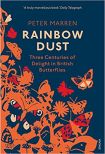Rainbow Dust: Three Centuries of Delight in British Butterflies by Peter Marren
| Rainbow Dust: Three Centuries of Delight in British Butterflies by Peter Marren | |
|
| |
| Category: Animals and Wildlife | |
| Reviewer: Rebecca Foster | |
| Summary: An enthusiastic, wide-ranging book about Britain’s butterflies, from the earliest collectors and entomological societies to today’s nature reserves and academic research. | |
| Buy? Maybe | Borrow? Yes |
| Pages: 320 | Date: July 2016 |
| Publisher: Vintage | |
| ISBN: 9781784703189 | |
|
| |
Peter Marren is a wildlife writer based in Wiltshire. His fascination with butterflies began when he was a child: he still remembers catching a Painted Lady in his hands at the age of five and it transferring some of its colours onto his palm. Rainbow dust, he dubbed it. 'It was a Nabokov moment because only he could put into words what most of us can only feel: the frankly sensual moment in a child's life when the full force of nature is felt for the first time.'
Collecting butterflies has fallen into disrepute nowadays, but in the 1950s, when Marren was growing up, it was still acceptable. It was a hobby with a grand tradition dating from the late seventeenth century. The first English entomological body, founded around the 1730s, called itself the Society of Aurelians. Some of the earliest known butterfly collections are now in the British Library, the British Museum, and the Oxford University Museum. Women also became involved in amateur entomological research early on. Case in point: Elinor Glanville (1654–1709), after whom the Lady Glanville's Fritillary was named.
From the history of collecting, Marren broadens outwards to consider butterflies themselves: the possible origins of the word 'butterfly' and of individual species names; ancient evidence of butterflies in cave paintings and later in medieval and Renaissance art; butterflies' metaphorical associations and frequent use in advertising; some famous butterfly illustrators; and so on. Each chapter is named after a particular species or two and headed and closed by black-and-white images taken from Papilionum Britanniae Icones by James Petiver (1717) or An Illustrated Natural History of British Butterflies by Edward Newman (1871).
I was especially interested in the sections in which Marren explores butterflies' cultural representations, whether in art or in literature. Chapter 4, 'Gatekeepers', focuses on the work of John Fowles and Vladimir Nabokov. Fowles's The Collector is a creepy novel about a butterfly collector whose obsession leads him to kidnap an art student and keep her under lock and key. Nabokov's love of butterflies is well known; he even curated the Lepidoptera at Harvard's Museum of Comparative Zoology. He discusses his collecting in his autobiography, while metaphors of desire and capture pervade his fiction, as in Lolita.
Marren brings his discussion up to the present day by profiling extinct species and reintroduction projects. For instance, although the Large Blue was declared extinct in Britain in 1980, a Scandinavian colony was released in Southwest England and seems to be doing well. In 2013 Marren made a pilgrimage to Somerset and managed to see a couple of the elusive creatures. This is 'rewilding' on the small scale, an attempt to make amends for our destruction of habitats. With one-third of European species currently in decline, there is plenty of work to do. Nature reserves and academic research are part of the solution, but both are generally underfunded and rely on volunteers and citizen scientists to provide data.
Ultimately, Marren acknowledges, 'it is hard to make an economic case for butterflies. We do not need them; nor, in the natural order of things, do they need us. But we care about them all the same, because that is the way we are.' For many people, butterflies are a source of beauty and wonder, which can translate into a passion for preserving the natural world. I think people who already have a particular love of butterflies will enjoy this book most, but it should inspire any reader to pay more attention to them. The appendix of British butterflies, listed in order from commonest to rarest, should prove a helpful tool for beginners.
Further reading suggestion: A Buzz in the Meadow by Dave Goulson is a highly recommended and entertaining read, mostly about insects. For our younger readers, 100 Facts Butterflies & Moths by Steve Parker is a perfect introduction.
Please share on: ![]() Facebook,
Facebook, ![]() Twitter and
Twitter and
![]() Instagram
Instagram
![]() You can read more book reviews or buy Rainbow Dust: Three Centuries of Delight in British Butterflies by Peter Marren at Amazon.co.uk Amazon currently charges £2.99 for standard delivery for orders under £20, over which delivery is free.
You can read more book reviews or buy Rainbow Dust: Three Centuries of Delight in British Butterflies by Peter Marren at Amazon.co.uk Amazon currently charges £2.99 for standard delivery for orders under £20, over which delivery is free.
![]() You can read more book reviews or buy Rainbow Dust: Three Centuries of Delight in British Butterflies by Peter Marren at Amazon.com.
You can read more book reviews or buy Rainbow Dust: Three Centuries of Delight in British Butterflies by Peter Marren at Amazon.com.
Comments
Like to comment on this review?
Just send us an email and we'll put the best up on the site.


